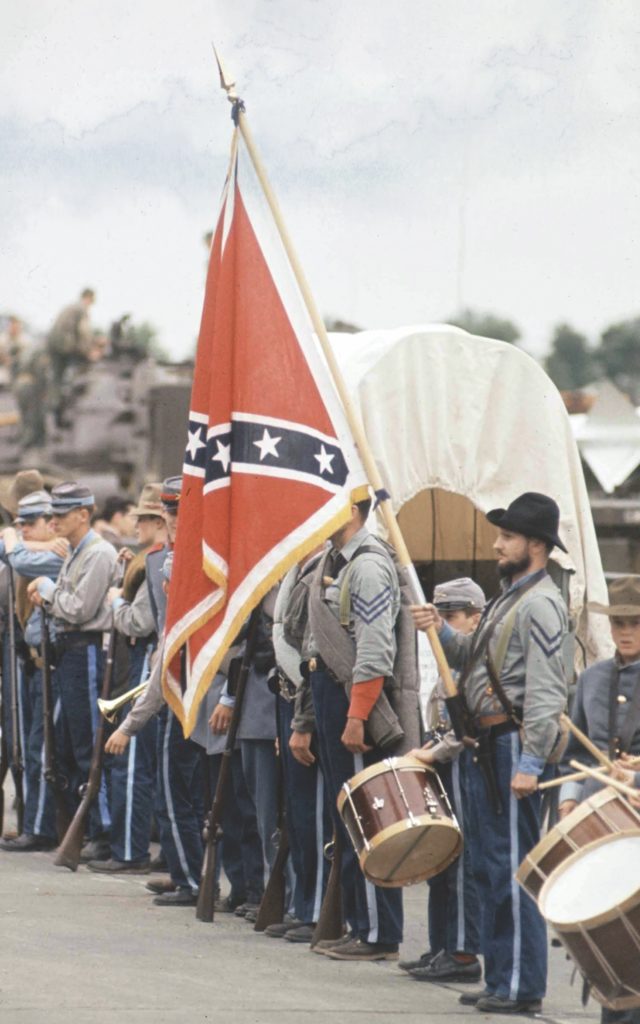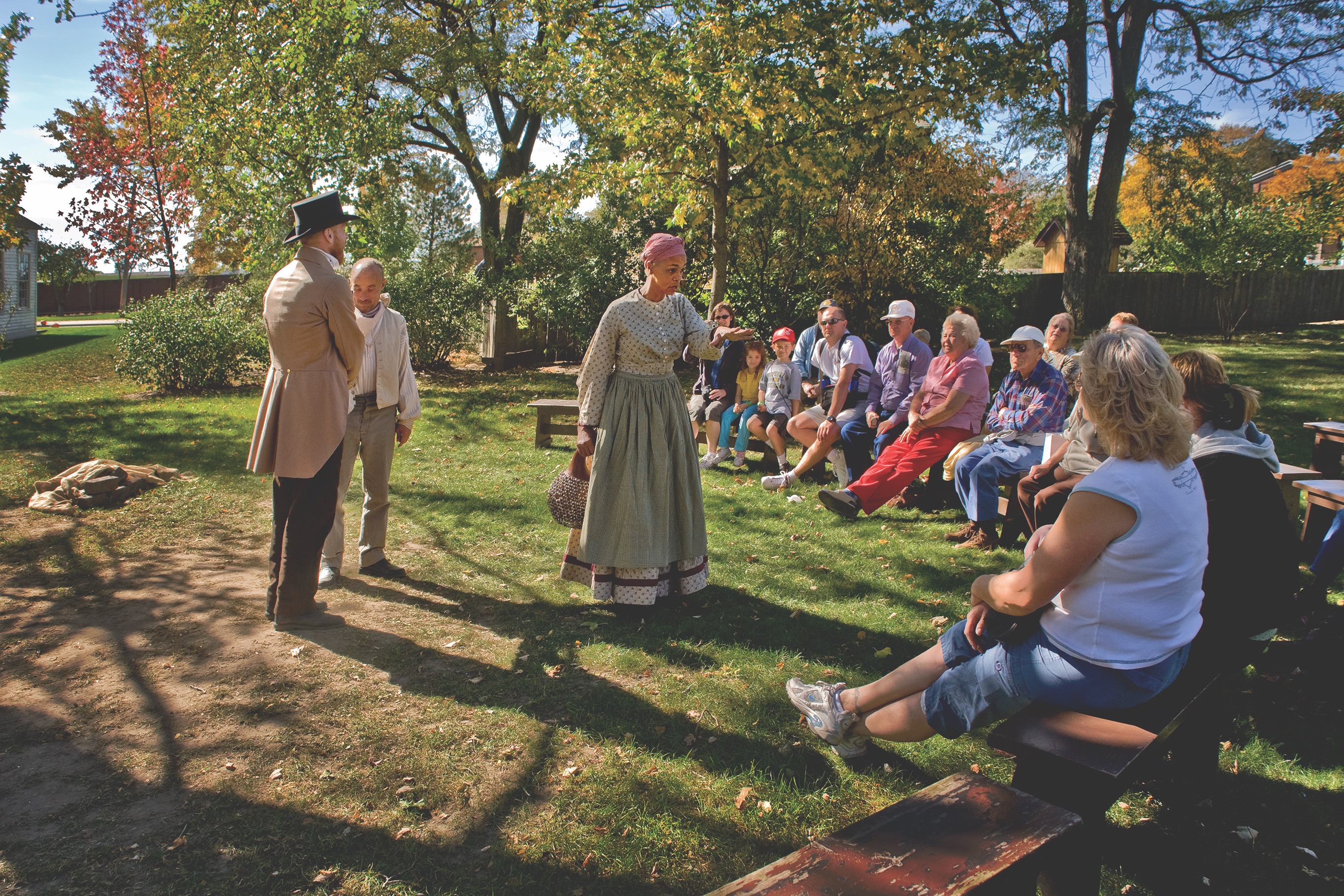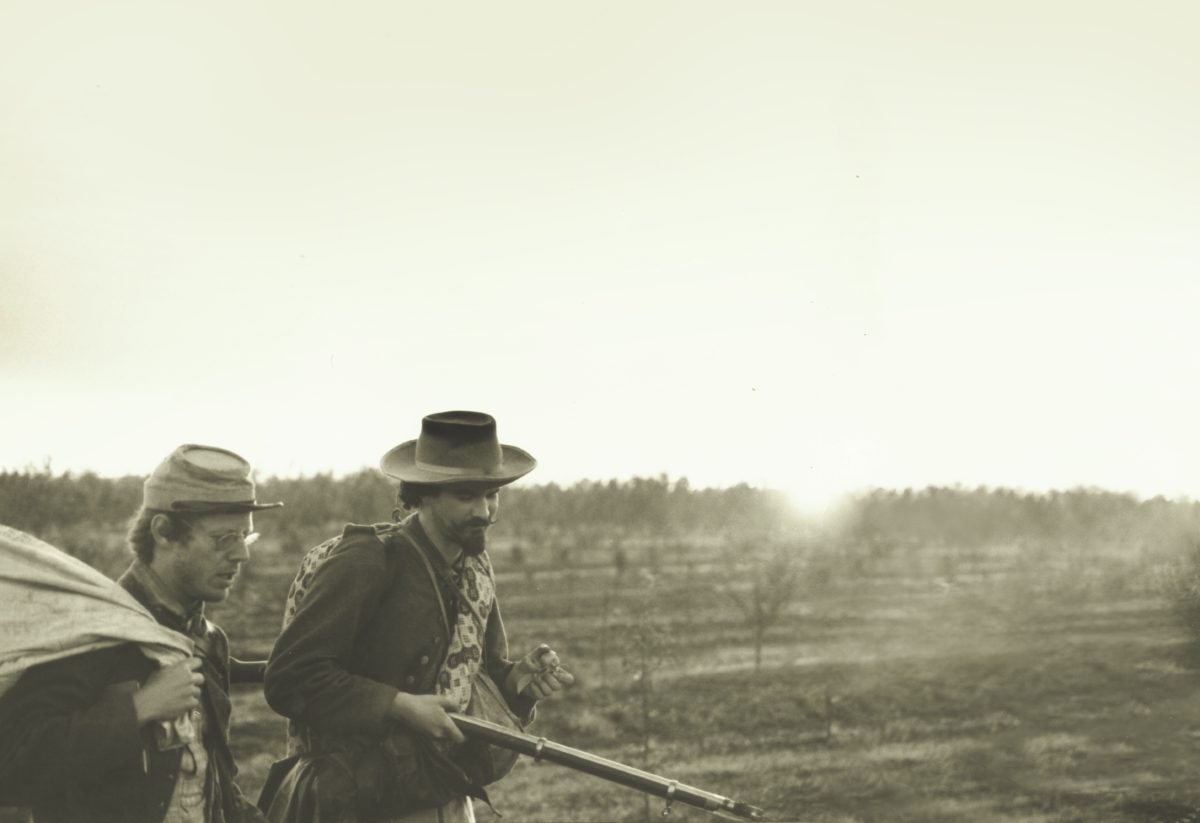America’s fascination with the Civil War may not have changed much since Tony Horwitz explored the South in Confederates in the Attic, but Horwitz said the way people are invested in the history has shifted.
Published in 1999, Confederates in the Attic was Horwitz’s answer to his boyhood passion for the Civil War. The book features Horwitz, a Pulitzer Prize–winning journalist, as the protagonist, navigating the South and along the way meeting a plethora of characters who share a vibrant passion for the Civil War, history, and Confederate culture. Juggling the opinions of Confederate descendants and their opponents, as well as his own perspective, Horwitz produced a journalistic story with humor and thought-provoking commentary.
Though the book is a seamless recollection of his travels weaved with the history of the sites, his research process for the book was to not have much of a process at all, he said. “I set off with the general idea of exploring the contemporary landscape of the Civil War and then pretty much went where my encounters led me. I tried to hit certain historic landmarks, like Fort Sumter and Richmond and Vicksburg, but wasn’t rigid about this and spent a considerable amount of time in small communities I’d never heard of.”

After his approximately 18-month excursion, he spent what he called a “difficult year” deciphering his notes, reading, and conducting archival research. Most of the book was firsthand reporting, and Horwitz said he didn’t have a well-defined process while writing his material—though it was more defined than his travels because his notes guided his writing.
“I just dove in and let the material lead me through the narrative,” Horwitz said. “As much as possible, I recounted my travels in the order they occurred, so that the reader experienced the South as I had. I tried to find the right balance of history, humor, and hard-nosed reporting so that one element didn’t overwhelm the others. Also, of course,
I threw away 75 percent of my reporting and focused on the best material.”
Horwitz said he was pleasantly surprised when the book debuted. He didn’t expect the wide acceptance and positive reviews so quickly.
“I knew there were plenty of people riveted by the Civil War but had no idea if my rather quirky approach would find a readership,” he said. “I was also gratified that so many Southerners responded, mostly positively, though a vocal minority took issue with me, mostly conservative neo-Confederates who claimed I’d misrepresented and defamed the Cause.”
The book’s initial success hasn’t diminished. Even up to his death, Horwitz continued to receive e-mails every week from readers, some from high school and college students assigned the book in class. And he said when topical debates surfaced periodically—noting the Rebel flag or related issues—he typically saw a spike in e-mails and media interview requests.
What Horwitz would have said in an interview changed over the years, as he noted the people of the South have changed much since he wrote the book, so the South he presented in Confederates in the Attic wasn’t the same anymore.
“Watching cable TV or reading the news, it’s easy to imagine that America is hopelessly divided and on the brink of another civil war,” Horwitz said. “The biggest change is demographic, due to the influx of Hispanics, Asians, African Americans from the North, and others. A diminishing percentage of people living in the South have a blood tie to the Confederacy or a passion for honoring it. This is particularly so among the young and in fast-growing urban centers.”
Those changes in demographics represent a change in attitudes. For instance, in Confederates in the Attic, Horwitz described an instance when AT&T supported removing the Rebel flag. Horwitz quoted a man as saying, “We won’t spend any of our money on a phone company that likes queers!” and then wrote, “What exactly this had to do with the rebel flag isn’t clear.” Later in the book, he recounted a conversation with Frances Chapman, who said, “Blacks just need to get over slavery. You can’t live in the past….Don’t put us where they used to be.” But Horwitz contended that those incidents didn’t define current Confederate culture.
“Those incidents were true to the world I explored in the 1990s and spoke to the way in which, for some white Southerners, the Confederacy, and its symbols had floated free from historical context, becoming fodder for a contemporary culture war,” Horwitz explained. “A sector of white Southern society that feels discomfort with the rapid change in America—regarding race, immigration, gender—chooses to use the flag and other emblems as a rallying point and bludgeon. But I don’t think this amounts to a ‘defining rhetoric’ for any but an aging minority.”
With a turn from the commitment to the Confederate cause came a shift in the way the Civil War—and the South’s history in general—is presented in the states that comprised the Confederacy, Horwitz said. With fewer people dedicated to preserving the memory of their ancestors’ hard-fought battles, a more open approach to historical events and challenges has taken hold. The difference in interpretation of plantations, museums, and other sites in the present day compared with the 1990s is striking, he says.
“Slavery is presented much more fully and honestly than before, as a central part of the history of that era,” he said. “You see many more African Americans at these sites, as employees and as visitors. We still have a long way to go in confronting all the ghosts of our past, but a lot of progress has been made in just the last twenty years.” Of course, as Horwitz noted, there are still some who want to defend the Rebel flag and emblems of the Confederacy. But to him, “they’re fighting a rearguard action.”
And as for the Confederate heritage groups Horwitz describes in Confederates in the Attic? “[They] used to operate a bit like the National Rifle Association, threatening to dislodge any legislator who didn’t fully embrace their agenda,” Horwitz said. “That power is gone, as we saw most vividly with the lowering of the flag at the South Carolina statehouse.”
But the Rebel flag has crept out of the Confederate museums and into the hands—and wardrobes—of many. Plastered on belt buckles and car decals, and flown off the back of pickup trucks in even the northernmost parts of the United States, the flag has a legacy of its own.
“During the Civil War, it was a battle standard, not a political emblem, and for many Southern veterans in the decades that followed, it was a symbol of their combat service and sacrifice,” explained Horwitz, who wrote:
But over time, the flag took on other connotations, including its appropriation by the Ku Klux Klan as a symbol of white supremacy and resistance to civil rights. In the 20th century, the flag was also commercialized, plastered on beach towels and bikinis and license plates, not only as an emblem of Southernness but as a more generalized expression of rebel-dom, a raised middle finger.

That raised middle finger may represent the original intent of the flag best, though. The anti-establishment ideas push against the politicians who, as Horwitz observed, tend to “draw on history in ways that suit their aims and ambitions.”
“As a result, knotty issues with complex historical roots—for instance, the Founders’ intent when they crafted the Second Amendment—get reduced to a sound bite,” Horwitz lamented. “But the responsibility for this rests as much on the public as it does on politicians. We need to be better educated about our history and ask hard questions when we hear politicians claim the mantle of Thomas Jefferson or Abe Lincoln or some other icon.”
That responsibility to be historically vigilant is something Horwitz explored in Confederates in the Attic along with his own fascination with the Civil War, which he passed on to his reluctant wife, novelist Geraldine Brooks. Initially, Brooks called him a “Civil War bore,” but she was drawn in just the same. “It wasn’t the battlefields that truly stirred her interest; it was the human and family drama of what happens to both men and women during war,” Horwitz said. “I think this speaks to the breadth of the subject. While many Civil War buffs are drawn in their youth to the great leaders and battles, there’s so much more to the story, including the home front. So for all the tens of thousands of books that have been written, there’s always new territory to explore.”
Brooks’ experience of the Civil War alongside Horwitz led her to write March, which won the 2006 Pulitzer Prize for fiction. March retells Louisa May Alcott’s story Little Women from the perspective of the father’s experience as a Union chaplain in the Civil War.
“I retract unreservedly my former characterization of my husband…as a Civil War bore,” Brooks wrote in March’s afterword.
I would like to apologize for all the times I refused to get out of the car at Antietam or whined about the heat at Gettysburg; for all the complaints about too many shelves colonized by his Civil War tomes and all the moaning over weekend expeditions devoted to events such as the interment of Stonewall Jackson’s horse. I’m not sure quite when or where it happened, but on a sunken road somewhere, I finally saw the light.
But Horwitz and Brooks certainly weren’t the first nor the last to discover a fascination with the war. The cover of Confederates in the Attic boasts a large black-and-white photo of a burly man in a plaid shirt holding a large “D-handled” Bowie knife. His stone face holds a glare—his furrowed brow highlighted by dirt. To someone who doesn’t know better, it seems to be a Civil War–era photograph. But a couple of chapters into the book, the reader finds out it is Robert Lee Hodge—a “hardcore” reenactor. Horwitz noted in Confederates that Hodge is known for his ability to lie stiffly on the ground and make his limbs appear bloated, as the dead in the war would look in a photograph.
In an article for America’s Civil War in March 2008, Hodge wrote that he felt naïve. When Horwitz asked to join their reenactment to do a story for the Wall Street Journal, Hodge invited him. “Initially, I thought the article would be positive, but when I read the piece I was disappointed,” Hodge said. “I never wanted any popularity for mimicking a bloated corpse or urinating on buttons.” Hodge went on to say he didn’t want to be the poster child for reenactment because he felt many others had a lot to offer as well.
After Confederates in the Attic gained popularity, though, Hodge became a center of media attention because, as he said, “there I was, on the cover of the book.” Despite this, he said his experience with Horwitz was positive and that the fifteen minutes of fame that came with it was both humbling and amusing—sentiments that some reenactors feel simply by donning the garb of the era.

Horwitz revisited a Civil War–related topic in his 2011 book, Midnight Rising: John Brown and the Raid That Sparked the Civil War. He said his interest in telling the story sparked from a desire to understand the beginnings of the war, as well as to explore the Northern side of the conflict more. He also wanted to experiment with writing traditional historical narrative in contrast to his work in Confederates in the Attic and other books, which weave together the past and present narratives.
“Like most Civil War buffs, I’d always focused on the 1861–65 period, and I wanted to get a better understanding of how Americans came to this bloody crisis in the first place,” Horwitz explained. “John Brown seemed a good way to get into all that, and I was also struck by how dramatic and misunderstood the story of Brown and the raid were.”
After moving to New England from Virginia about 14 years ago, Horwitz no longer purposely visited battlefields and other sites, though he often returned to the South for research, and because of the pervasive history of the Civil War, some sites were inescapable, he said. “While looking for something else, I often stumbled on intriguing, little-known sites. But I’m more focused these days on the antebellum South or contemporary issues—not the Civil War years, per se.”
Even without constant immersion in Civil War-specific history and sites, Horwitz’s appreciation of the stories of the era remains strong.
“Simply put, the Civil War is the most engaging, dramatic, and consequential episode in U.S. history, and its echoes can be heard in the present day,” Horwitz said. “In so many ways, studying that era provides a window into our history and character as a nation.” Gertrude Stein put it best: ‘There never will be anything more interesting in America than that Civil War[,] never.’”
Hannah R. Gordon is a Buffalo, N.Y.–based author, photographer, and podcaster. A St. Bonaventure University graduate, she was given the “Civil War history bug” by her former professor, Emerging Civil War founder Chris Mackowski. She can be found on all social media platforms @HR_Gordon and at www.HannahRGordon.com.





